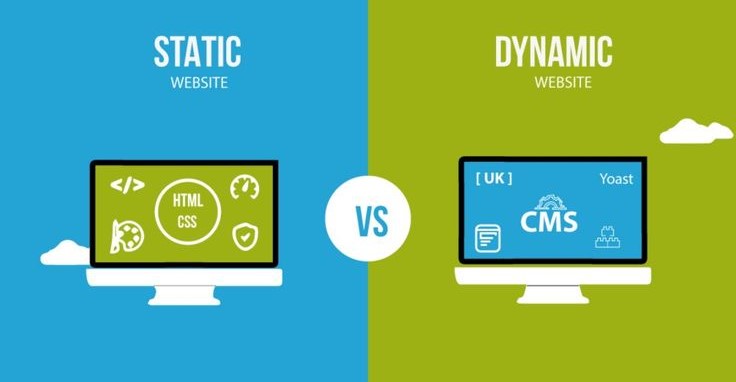Introduction: The Digital Showdown
In today’s business world, your website is your digital storefront, and the choice between a dynamic or static website is one of the first big decisions you’ll face.
 Get this right, and you’re set for success. Get it wrong, and you’ll be patching up performance, security, and scalability issues before you even get off the ground.
Get this right, and you’re set for success. Get it wrong, and you’ll be patching up performance, security, and scalability issues before you even get off the ground.
So, what exactly is the difference? And which is the right fit for your business?
What Is a Static Website?

A static website is made up of fixed HTML, CSS, and sometimes JavaScript files. When someone visits your site, the browser simply fetches and displays the exact files stored on the server, no database calls, no content generation on the fly.
✅ Benefits of Static Websites:
- Speed: Blazing fast because there’s no server-side processing.
- Security: Fewer attack vectors (no database = fewer headaches).
- Low cost: Cheaper to host and maintain.
- Reliability: Fewer moving parts mean fewer chances of breakage.
- Great for SEO: Google loves fast sites.
❌ Limitations:
- Not interactive: No logins, no comments, no user-generated content.
- Harder to update (without a CMS): You’ll need to manually edit code or use a static site generator.
- Limited scalability for complex use-cases like eCommerce or large content libraries.
Ideal for: Portfolios, product pages, company profiles, digital brochures.
What Is a Dynamic Website?

A dynamic website pulls content from databases and generates pages in real-time based on user actions or system logic. Think WordPress, Shopify, Zoho Sites, or any modern CMS-powered site.
✅ Benefits of Dynamic Websites:
- Interactive: Contact forms, live chats, user dashboards – you name it.
- Scalable: Add thousands of products, blogs, or users without breaking structure.
- Easier updates: With a CMS, anyone (even non-techies) can update content.
- Personalization: Show different users different content.
❌ Limitations:
- Slower load times: Server-side rendering takes time.
- More expensive: You’ll need better hosting and possibly a developer.
- Security risks: Vulnerabilities increase with complexity.
Ideal for: eCommerce sites, news platforms, membership portals, and apps.
Static vs Dynamic: A Quick Comparison Table
| Feature | Static Website | Dynamic Website |
| Page Load Speed | ⚡ Ultra-fast | 🌀 Slower, depends on the backend |
| Hosting Costs | 💸 Low | 💰 Higher |
| Interactivity | ❌ Limited | ✅ High |
| Maintenance | 🔧 Manual (unless using CMS) | 🔄 Easy via CMS |
| Security | 🔒 More secure | 🔓 Needs constant monitoring |
| Best Use-Case | Portfolio, landing pages | Blogs, eCommerce, portals |
Which One Should You Choose?
Go Static If:
- You want speed and simplicity.
- You’re a freelancer, small firm, working anywhere remotely, or a service provider.
- You only update content occasionally.
- You care about SEO and page speed scores.
Go Dynamic If:
- You need a blog or frequently updated content.
- You want users to sign up, shop, or engage.
- You’re planning long-term growth with content or products.
- You have a team managing different parts of the site.
The Hybrid Approach: Best of Both Worlds?
Some platforms now offer headless CMS or Jamstack approaches, where content is managed like a dynamic website but delivered like a static one.
You get CMS convenience + static speed. It’s worth exploring if you’re scaling up.
Too Long; Didn’t Read?
Static websites are lightning-fast, budget-friendly, and perfect for businesses that just need an online presence.
Dynamic websites are interactive, database-driven, and ideal for businesses that need user interaction, frequent updates, or e-commerce.
Verdict: Choose based on your goals, budget, and content needs, not the hype.
Final Verdict: It’s About Purpose, Not Popularity
Don’t chase trends. Pick a website type that aligns with your business model, budget, and technical comfort.
A well-built static site can outperform a sluggish dynamic site any day. And a powerful dynamic site can automate half your business.
💡 It’s not about what’s better, it’s about what’s better for your goals.